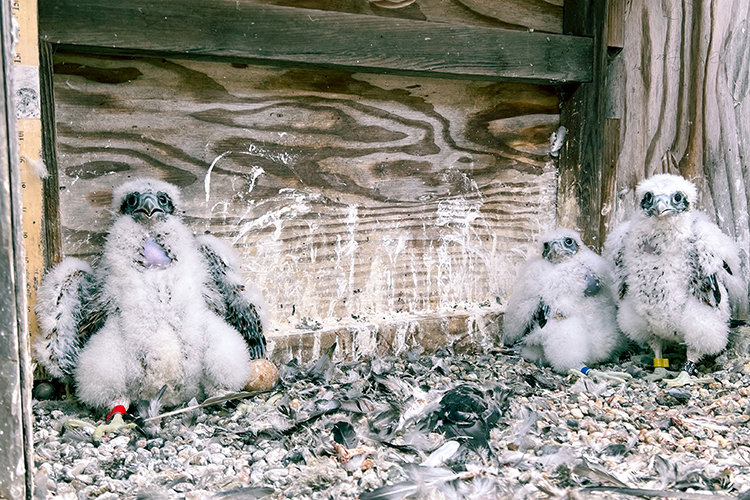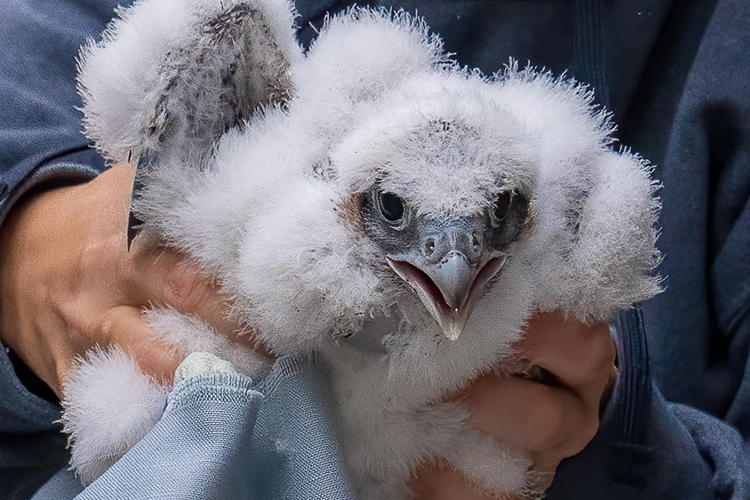Contest starts today to name UC Berkeley’s three falcon siblings
Annie and Lou have one male and two female chicks, and they're already nearly full-sized.
May 5, 2023

Three siblings: The largest female is on the left, her brother on the far right, and her sister in the middle. The colored tape on their right legs will help distinguish them from each other until it wears away. (Image: Mary Malec)
Another rite of spring has arrived: A contest to name the newest peregrine falcons on UC Berkeley’s Campanile. And as of this morning, the three chicks — offspring of Annie and Lou — got their first checkups and were fitted with identification bands by a raptor biologist who determined that there are two females and one male.
Cal Falcons launched the naming contest today at noon, and it’s open to the public via the group’s social media channels — Twitter, Instagram and Facebook. The contest will close to suggestions on Monday, May 8, and finalist names will be announced on the 9th. After the public’s vote on those, the three winning names will be revealed Friday, May 12.
A separate children’s contest, to name the falcons, can be found here.

Dr. Zeka Glucs, director of the Santa Cruz Predatory Bird Research Group, comes to UC Berkeley annually to examine and band the new falcon chicks in the tower. Here, she uses her bare hands instead of wearing gloves so that the chick’s fragility can be acutely felt and safeguarded in the process. (Image: Bridget Ahern)
Less than a month ago, the chicks hatched in their gravel nest box; now they are nearly full-sized. One female is significantly larger than her siblings, but all three are developing normally and beginning to sprout wing and tail feathers.
“They’re eating a lot of pigeon,” added Sean Peterson, an environmental biologist with Cal Falcons. Just as today’s examination and banding — completed by Dr. Zeka Glucs, director of the Santa Cruz Predatory Bird Research Group — ended, Lou flew in carrying a large bird for the family of five’s next meal.
Glucs gave each chick two leg bands that will stay in place for the rest of the birds’ lives. The first band was issued by the national Bird Banding Laboratory and has a unique nine-digit number that differentiates the chick from all other birds banded in North America. That band number is associated with all the data collected about the bird at the time of banding.

Annie is out doing more hunting now than she did when the chicks were younger, helping her mate Lou. The chicks are growing and getting hungrier. (Image: Bridget Ahern)
The second band has only four characters in much larger type that can be seen through binoculars from afar. This four-character code is enough to differentiate the falcon from other falcons in the region.
Blue electrical tape was put on one female chick’s Bird Banding Laboratory band, and red on the other female’s band. The male received yellow tape on his band. When fledging begins, the colored tape will help volunteers monitoring the young birds’ first flights off the tower — they’re expected to begin in about two weeks — to distinguish one falcon from the other.
About 9 a.m. this morning, Glucs, raptor expert Mary Malec from Cal Falcons, and several guests climbed the tall, narrow spiral staircase within the bell tower to reach the falcons’ nest box on a level above the observation deck.

Annie shrieked and made many passes over the heads of the people involved with banding her chicks. Several of the visitors felt her feet thump on their heads. (Image: Andrew Weiss)
The flooring of the narrow balcony where the nest box sits was littered with the remains of prior falcon meals — a wing here, feathers there — and lots of bird droppings. Glucs sat on the ground next to the nest and calmly, quickly and ethically measured the width of each chick’s legs, right above its feet, to determine the bird’s sex. Males’ leg bones are thinner in that part of the leg than the females’ are.
Glucs also took pin feathers from each bird’s upper back — for studies about any heavy metals present in birds of prey and also for genetic studies — and put them in small brown envelopes that she labeled, one for each chick. Malec crouched next Glucs and helped her by recording data about the birds in a small book.
Meanwhile, Annie, soaring in the skies nearby, made dozens of passes at top speed over the humans near her nest, deliberately knocking her feet on several of their heads or clothing in an attempt to chase the visitors away from her young.

Annie and Lou’s offspring are now nearly full-sized and beginning to acquire their wing and tail feathers. (Image: Sparky Carranza)
“She was a little fiercer today than usual,” said Malec, after the team had exited the tower. “She recognizes what’s about to happen; we’re getting familiar to her” after all these years. Annie chose the Campanile as her territory in late 2016 along with her first mate, Grinnell, who died a year ago.
Annie is now venturing away from the nest a bit more to help Lou with the hunting, since the chicks are bigger and hungrier, said Peterson. The pair can’t sit on their chicks any longer, to keep them warm, as they’ve grown so large. But he said Annie still spends the night with them in the nest box.
“The largest chick has left the next box accidentally a couple of times,” said Peterson, “so she’s starting to explore her environment pretty well. It won’t be too much longer before the chicks really start to move around and have fun.”
You can watch the falcon family’s activities 24/7 via the three webcams on the Campanile.